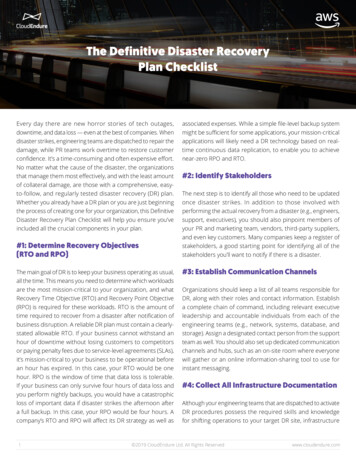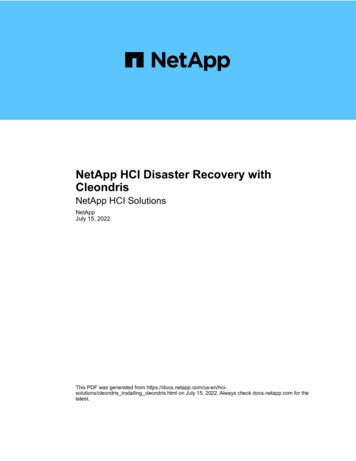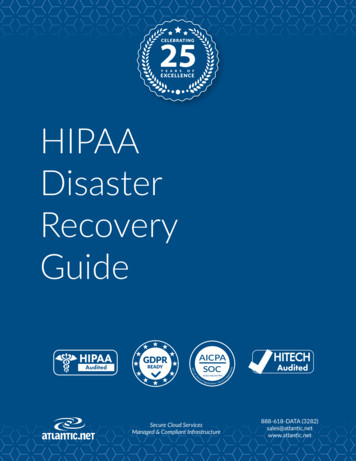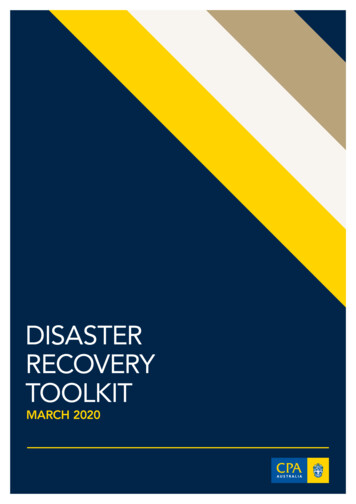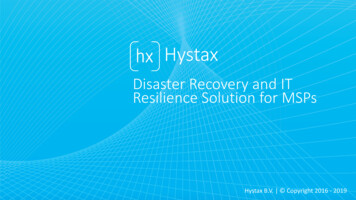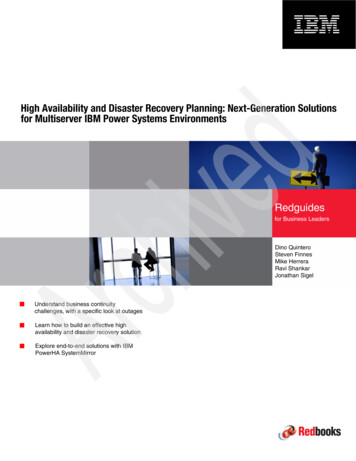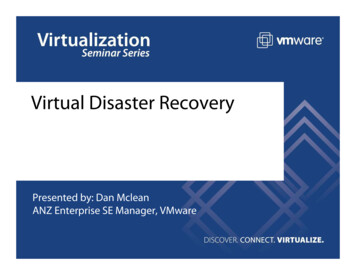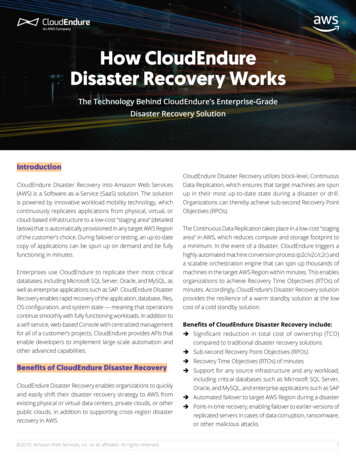
Transcription
How CloudEndure Disaster Recovery WorksHow CloudEndureDisaster Recovery WorksThe Technology Behind CloudEndure’s Enterprise-GradeDisaster Recovery SolutionIntroductionCloudEndure Disaster Recovery into Amazon Web Services(AWS) is a Software-as-a-Service (SaaS) solution. The solutionis powered by innovative workload mobility technology, whichcontinuously replicates applications from physical, virtual, orcloud-based infrastructure to a low-cost “staging area” (detailedbelow) that is automatically provisioned in any target AWS Regionof the customer’s choice. During failover or testing, an up-to-datecopy of applications can be spun up on demand and be fullyfunctioning in minutes.Enterprises use CloudEndure to replicate their most criticaldatabases, including Microsoft SQL Server, Oracle, and MySQL, aswell as enterprise applications such as SAP. CloudEndure DisasterRecovery enables rapid recovery of the application, database, files,OS configuration, and system state — meaning that operationscontinue smoothly with fully functioning workloads. In addition toa self-service, web-based Console with centralized managementfor all of a customer’s projects, CloudEndure provides APIs thatenable developers to implement large-scale automation andother advanced capabilities.Benefits of CloudEndure Disaster RecoveryCloudEndure Disaster Recovery enables organizations to quicklyand easily shift their disaster recovery strategy to AWS fromexisting physical or virtual data centers, private clouds, or otherpublic clouds, in addition to supporting cross-region disasterrecovery in AWS. 2019, Amazon Web Services, Inc. or its affiliates. All rights reserved.CloudEndure Disaster Recovery utilizes block-level, ContinuousData Replication, which ensures that target machines are spunup in their most up-to-date state during a disaster or drill.Organizations can thereby achieve sub-second Recovery PointObjectives (RPOs).The Continuous Data Replication takes place in a low-cost “stagingarea” in AWS, which reduces compute and storage footprint toa minimum. In the event of a disaster, CloudEndure triggers ahighly automated machine conversion process (p2c/v2c/c2c) anda scalable orchestration engine that can spin up thousands ofmachines in the target AWS Region within minutes. This enablesorganizations to achieve Recovery Time Objectives (RTOs) ofminutes. Accordingly, CloudEndure’s Disaster Recovery solutionprovides the resilience of a warm standby solution at the lowcost of a cold standby solution.Benefits of CloudEndure Disaster Recovery include:ÎÎ Significant reduction in total cost of ownership (TCO)compared to traditional disaster recovery solutionsÎÎ Sub-second Recovery Point Objectives (RPOs)ÎÎ Recovery Time Objectives (RTOs) of minutesÎÎ Support for any source infrastructure and any workload,including critical databases such as Microsoft SQL Server,Oracle, and MySQL, and enterprise applications such as SAPÎÎ Automated failover to target AWS Region during a disasterÎÎ Point-in-time recovery, enabling failover to earlier versions ofreplicated servers in cases of data corruption, ransomware,or other malicious attacks1
How CloudEndure Disaster Recovery WorksÎÎ One-click failback, restoring operations to source serversautomaticallyÎÎ Unlimited, non-disruptive disaster recovery drillsContinuous Data ReplicationAt the core of CloudEndure’s technology is our proprietaryContinuous Data Replication engine, which provides realtime, asynchronous, block-level replication.CloudEndure replication is done at the OS level (rather thanhypervisor or SAN level), enabling support of the followingtypes of source infrastructure:ÎÎ Physical machines, including both on-premises and colocation data centersÎÎ Virtual machines from any hypervisor, including VMware,Microsoft Hyper-V, and othersÎÎ Cloud-based machines, including AWS, Microsoft Azure,Google Cloud Platform (GCP), Oracle Cloud, IBM Cloud,OpenStack, and othersÎÎ Replication is also supported between Regions or AvailabilityZones in AWSOnce installed and activated, the CloudEndure Agent beginsinitial replication, reading all of the data on the machines atthe block level and replicating it to a low-cost “staging area” thatis automatically provisioned in a customer’s AWS account, in atarget network of their choice. Customers define replicationsettings, such as subnets, security groups, and replication tags,through the self-service, web-based CloudEndure Console.The initial replication can take anywhere from several minutes toseveral days, depending on the amount of data to be replicatedand the bandwidth available between the source infrastructureand the target AWS Region. No reboot is required nor is theresystem disruption throughout the initial replication.After the initial replication is complete, the source machines areCloudEndureConsoleReplicationSettingsCustomers selectsource infrastructureand target AWSRegion, subnets,security groups,and more from theCloudEndure Consolebefore beginninginitial replication. 2019, Amazon Web Services, Inc. or its affiliates. All rights reserved.2
How CloudEndure Disaster Recovery Workscontinuously monitored to ensure constant synchronization,up to the last second. Any changes to source machines areasynchronously replicated in real time into the AWS “stagingarea.”Unlike snapshot-based replication, Continuous DataReplication enables customers to continue normal IToperations during the entire replication process withoutperformance disruption or data loss.Continuous Data Replication allows customers to achievesub-second Recovery Point Objectives (RPOs), as the datais always up-to-date and ready to be spun up as soon as adisaster strikes.CloudEndure’s replication engine is application-agnostic,supporting all application types, including databases andlegacy applications, any source infrastructure, and a widearray of operating systems.Low-Cost “Staging Area” in TargetAWS RegionCloudEndure maintains ongoing replication of sourcemachines into a low-cost “staging area” in the customer’spreferred target AWS Region. The “staging area” contains costeffective resources automatically provisioned and managed byCloudEndure to receive the replicated data without incurringsignificant costs. These resources include a small number oflightweight VMs (each supporting multiple source machines),disks (one target disk for each replicating source disk), andsnapshots.Whereas traditional disaster recovery solutions requireduplicate hardware, compute, storage, networking, andsoftware licenses in order to ensure data integrity and subsecond RPO, CloudEndure’s “staging area” eliminates the needfor duplicate provisioning of resources and thus significantlyreduces the TCO for disaster recovery. The fully provisionedrecovery environment, with the right-sized compute and higherCloudEndureConsoleList of Machines &Data ReplicationProgressThe CloudEndureConsole providesreal-time informationon the datareplication statusof each machine.Customers can addmachines, conductdrills, and launchfailovers and failbacksright from theConsole. 2019, Amazon Web Services, Inc. or its affiliates. All rights reserved.3
How CloudEndure Disaster Recovery Worksperformance storage required for recovered workloads, isonly launched during a disaster or a DR drill.Automated Orchestration of Target AWSEnvironmentCloudEndure’s orchestration engine automatically launchesfully operational workloads in the target AWS Region atthe time of failover or test. This automated process includescloning disks from the “staging area” to target networks andprovisioning all additional resources such as VMs, networkinterfaces, and firewalls.The entire orchestration process typically takes minutes,depending on the general time it takes the machines to boot.CloudEndure’s orchestration process is not impacted by thenumber or size of volumes or the number of VMs.A large number of machines can be directly provisioned in parallelwith a single click, using the appropriate predefined networkingand machine properties. Automated orchestration combinedwith machine conversion (detailed below) enables customers toachieve Recovery Time Objectives (RTOs) of minutes.Customers are able to select configuration settings for howmachines will be provisioned (orchestrated) in the target AWSRegion, instance/machine type, subnet, security groups, andelastic IP in the CloudEndure Console.Automated Machine ConversionWhen replicating machines across similar infrastructure, suchas between AWS Regions or Availability Zones, the replicatedmachines can boot natively in the target environment, asthere are no significant differences in infrastructure. However,when replicating machines across dissimilar infrastructure,such as from on-premises or other clouds into AWS, machineconversions are required to ensure that the replicatedmachines can continue to run natively within AWS. This includesmodifications to hypervisors, drivers, and other nSettingsCustomers areable to selectconfiguration settingsfor how machineswill be provisioned(orchestrated) in thetarget AWS Region,including instance/machine type, subnet,security groups,elastic IP, and more. 2019, Amazon Web Services, Inc. or its affiliates. All rights reserved.4
How CloudEndure Disaster Recovery WorksWithout proper conversion, such transitions between physicalmachines, hypervisor variations, or different clouds will resultin non-bootable target oudEndure addresses this using proprietary machineconversion technology, which handles all hypervisor and OSconfiguration changes, boot process changes, OS activation,and installation of target infrastructure guest agents.The automated machine conversion process takesapproximately 30 seconds and ensures that Windows orLinux machines replicated from physical, virtual, and cloudbased infrastructure will natively boot and run transparentlyin the customer’s preferred target AWS Region.Point-in-Timerecovery iscritical in casesof databasecorruptions,accidentalsystem changes,ransomware, orother maliciousattacks on s*OperatingSystems*Source Infrastructure*ApacheLinux LVMAmazon LinuxAWSApache CassandraLocal DisksCentOSAzureApache HbaseOracle ASMDebianCloudStackCouchDBRAID ArrayKaliGoogle Cloud Platform (GCP)Microsoft Active Directory SAN-Based DisksOracle LinuxIBM CloudMicrosoft Dynamics CRMRedHat LinuxKVMMicrosoft ExchangeSUSEMicrosoft Hyper-VMicrosoft IISUbuntuOpenStackMicrosoft SharePointWindows Server 2003,Oracle CloudMicrosoft SQL Server2008, 2012, 2016, 2019Physical ServersMongoDBWindows XP, Vista, 7, 8,VMwareMySQL8.1, 10XenStriped DisksApplications,HardwareConfigurations,Operating Systems,and SourceInfrastructureSupported byCloudEndure(partial list)NGINXOracle DatabaseOracle ERPOracle PeoplesoftPivotal CRMPostgreSQLRedis*As this is only a partiallist, please contactCloudEndure if you donot see your application,hardware configuration,OS, or infrastructure inthis table.SAP CRMSAP ERPSAP S/4 Hana 2019, Amazon Web Services, Inc. or its affiliates. All rights reserved.5
How CloudEndure Disaster Recovery WorksPoint-in-Time RecoveryIn many disaster recovery use cases, the goal is to spin up themost up-to-date state of the source machines and continueoperations as before. However, in cases of database corruptions,accidental system changes, ransomware, or other maliciousattacks, customers may need to recover environments to previousconsistent points in time. CloudEndure Disaster Recovery offersgranular point-in-time recovery, which protects and recoversdata and IT environments that have been corrupted.Automated FailbackOnce a disaster is over, CloudEndure provides automatedfailback to the source infrastructure. Because CloudEndure’sfailback technology utilizes the same agent-based blocklevel Continuous Data Replication engine, failback to sourcemachines is rapid and data is continuously synched inreal time from AWS until failback. CloudEndure’s automatedfailback supports both full as well as incremental restores.Enterprise-Grade SecurityIn order to ensure the highest level of security standards,data replication occurs directly from the customer’s sourceinfrastructure to the customer’s target AWS Region, and canbe restricted to private networks for better security, speed,and control. Server data never goes through CloudEndureduring the entire process.CloudEndure is ISO 27001-compliant, and provides in-transitdata encryption using AES 256-bit and data-at-rest encryptionin the customer’s target AWS RegionCloudEndure Network ArchitectureTCP 443 (SSL)CloudEndure Agent HandshakeAPIs to Create Staging Area &Launch Target MachinesCloudEndureUser ConsoleTCP 443 (SSL)Replication Server Configuration &Ongoing MonitoringAWS CloudWeb Proxy(optional)S3Target RegionCorporate Data Center / Any CloudAWS API EndpointWeb Proxy(optional)Staging Area VPC SubnetCloudEndureAgentCloudEndureAgentDisksTCP 1500Continuous DataReplicationTarget VPC SubnetLaunchedTarget EC2InstanceStaging AreaReplication Servers(Lightweight LinuxEC2 Instances)StagingEBS VolumesLaunchedTarget EC2InstanceTargetEBS VolumesEach replication server can support a large number of source machines, significantly reducing compute costs for disaster recovery purposes.This is in contrast to traditional disaster recovery solutions, which require a constantly running target server for each source machine.cloudendure-info@amazon.com aws.amazon.com/cloudendure-disaster-recovery 2019, Amazon Web Services, Inc. or its affiliates. All rights reserved.6
Microsoft Active Directory Microsoft Dynamics CRM Microsoft Exchange Microsoft IIS Microsoft SharePoint Microsoft SQL Server MongoDB MySQL NGINX Oracle Database Oracle ERP Oracle Peoplesoft . Windows Server 2003, 2008, 2012, 2016, 2019 Windows XP, Vista, 7, 8, 8.1, 10 AWS Azure CloudStack Google Cloud Platform (GCP) IBM Cloud KVM Microsoft .



